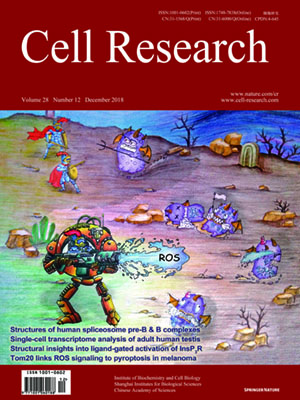
Volume 28, No 12, Dec 2018
ISSN: 1001-0602
EISSN: 1748-7838 2018
impact factor 17.848*
(Clarivate Analytics, 2019)
Volume 28 Issue 12, December 2018: 1186-1194 | Open Access
ORIGINAL ARTICLES
Small molecule inhibitors reveal allosteric regulation of USP14 via steric blockade
Yiwei Wang 2, Yuxuan Jiang 3, Shan Ding 1, Jiawang Li 4, Ningjing Song 1,5, Yujing Ren 4, Danning Hong 4, Cai Wu 3, Bin Li 3, Feng Wang 4,Wei He 3, Jiawei Wang 2 and Ziqing Mei 1
1Biotechnology Research Institute, Chinese Academy of Agricultural Sciences, Beijing 100081, China; 2Tsinghua-Peking Center for Life Sciences, School of Life Sciences, Tsinghua University, Beijing 100084, China; 3School of Pharmaceutical Sciences, Tsinghua University, Beijing 100084, China; 4School of Life Science, Beijing Institute of Technology, Beijing100081, China and 5School of Life Sciences, Anhui Agricultural University, Hefei, Anhui 230026, China
Correspondence: Correspondence: Feng Wang (wfeng@bit.edu.cn) or Wei He (Whe@tsinghua.edu.cn) or Jiawei Wang (jwwang@tsinghua.edu.cn) or Ziqing Mei (meiziqing@caas.cn)These authors contributed equally: Yiwei Wang, Yuxuan Jiang, Shan Ding, Jiawang Li
The ubiquitin system is important for drug discovery, and the discovery of selective small-molecule inhibitors of deubiquitinating enzymes (DUBs) remains an active yet extremely challenging task. With a few exceptions, previously developed inhibitors have been found to bind the evolutionarily conserved catalytic centers of DUBs, resulting in poor selectivity. The small molecule IU1 was the first-ever specific inhibitor identified and exhibited surprisingly excellent selectivity for USP14 over other DUBs. However, the molecular mechanism for this selectivity was elusive. Herein, we report the high-resolution co-crystal structures of the catalytic domain of USP14 bound to IU1 and three IU1 derivatives. All the structures of these complexes indicate that IU1 and its analogs bind to a previously unknown steric binding site in USP14, thus blocking the access of the C-terminus of ubiquitin to the active site of USP14 and abrogating USP14 activity. Importantly, this steric site in USP14 is very unique, as suggested by structural alignments of USP14 with several known DUB X-ray structures. These results, in conjunction with biochemical characterization, indicate a coherent steric blockade mechanism for USP14 inhibition by compounds of the IU series. In light of the recent report of steric blockade of USP7 by FT671, this work suggests a potential generally applicable allosteric mechanism for the regulation of DUBs via steric blockade, as showcased by our discovery of IU1-248 which is 10-fold more potent than IU1.
https://doi.org/10.1038/s41422-018-0091-x
FULL TEXT | PDF
Browse 1294


